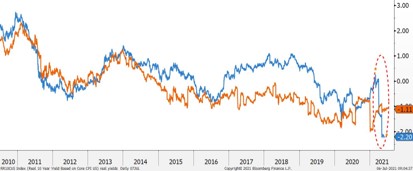
Forecast: Sunny Markets with a Risk of Delta Clouds
29 June 2021
Can the FX and Rates markets both be right?
14 July 2021INSIGHT • 7 July 2021
A turning point for the dollar?

Kevin Lester , CEO
The Fed wrong-footed the markets last month, indicating that interest rates would begin to rise in 2023, a year earlier than previously thought. This hawkish turn has led many to question the dominant narrative in FX markets – that the US dollar will fall in value against its G10 peers. With the market now pricing in a faster than expected return to rising US rates, and with the American economy significantly outperforming most other developed markets, is it time for dollar bears to admit defeat?
FX traders seem to think so. Following the Fed’s announcement, the dollar promptly rallied by two and a half cents against the euro, and by a similar amount against sterling. Suddenly, the bearish consensus on the dollar was thrown into doubt. Not only are interest rate differentials moving back in the dollar’s favour (US five-year yields rallied from about 0.7% to over 0.9% on the news), but the US economy appears to be weathering the COVID storm significantly better than the rest of the G10. While US GDP contracted by 3.5% in 2020, the eurozone shrank by almost 7%. And not only was the economic blow milder in the US, but the recovery appears to be stronger. While the US is expected to grow by about 7% this year, the eurozone is only projected to grow by about 4.5%.
So, is the combination of positive carry and superior economic performance enough to reverse the dollar’s downtrend? Maybe, but I would be cautious in calling this a turning point for the dollar.
The main reason to be wary about the dollar’s prospects is the same reason that prompted the Fed’s change of tone: inflation. US inflation is running far hotter than in most other developed markets, pushing US real (inflation-adjusted) yields far below those in the eurozone (see Chart 1). In simple terms, this makes it less attractive to hold US dollar assets despite the nominal yield advantage.
Chart 1: US 10-year inflation-adjusted yield (blue) vs. Eurozone 10-year inflation-adjusted yield (orange)

Source: Bloomberg
In our 2021 FX outlook, published back in January, we specifically discussed our expectation that inflation would likely run hotter than central banks (and the markets) were expecting, before concluding:
This outcome (stronger-than-expected inflation) is perhaps the trickiest to evaluate in terms of currency impact, as it really depends on the timing of the Fed’s actions with respect to YCC (Yield Curve Control). As US real yields begin to rise, we would expect the dollar to strengthen initially, helped by increased market volatility.
(Note: While, as we have seen US real yields are not yet rising (quite the opposite in fact!), any sustained US dollar rally would likely be predicated on the idea that they will, based on an assumption of ‘transitory’ inflation and / or an increasingly hawkish bias from the Fed.)
We predicted that in such a scenario EURUSD would drop towards 1.15 as markets initially priced in more aggressive Fed action. This is precisely what we are seeing now. We then concluded that such a reprieve for the dollar would likely be a temporary one, once it became clear that the Fed’s words would not be backed up by action.
American economist Nouriel Roubini recently wrote:
The Fed’s recent pivot from an ultra-dovish to a mostly dovish stance changes nothing. The Fed has been in a debt trap at least since December 2018, when a stock- and credit-market crash forced it to reverse its policy tightening a full year before Covid-19 struck. With inflation rising and stagflationary shocks looming, it is now even more ensnared.
I agree with Mr. Roubini on this. It is comparatively easy for the Fed to talk tough on inflation. In fact, this is exactly what we would expect them to do with US inflation reaching 5%. It is quite another thing for them to act. Should the market begin to doubt the Fed’s commitment to actual monetary tightening, then I would expect the dollar to weaken.
One could argue that the US is not the only central bank facing such an unenviable set of monetary policy choices, and therefore why is the US dollar any more vulnerable than the euro, the pound, or the Canadian dollar? The simple fact is that inflationary pressures in the US are much more advanced than in most other G10 countries. Headline inflation is already much higher (5% versus 2% in the eurozone), fiscal policy is more aggressive, and the US money supply is expanding faster than in other economies (e.g., since 2018, US M2 has grown by 45% compared to just 24% in the eurozone). If (and this remains the most important question for financial markets today) we are witnessing the return of inflation, then I do not see the US dollar as a particularly safe harbour.
Be the first to know
Subscribe to our newsletter to receive exclusive Validus Insights and industry updates.

